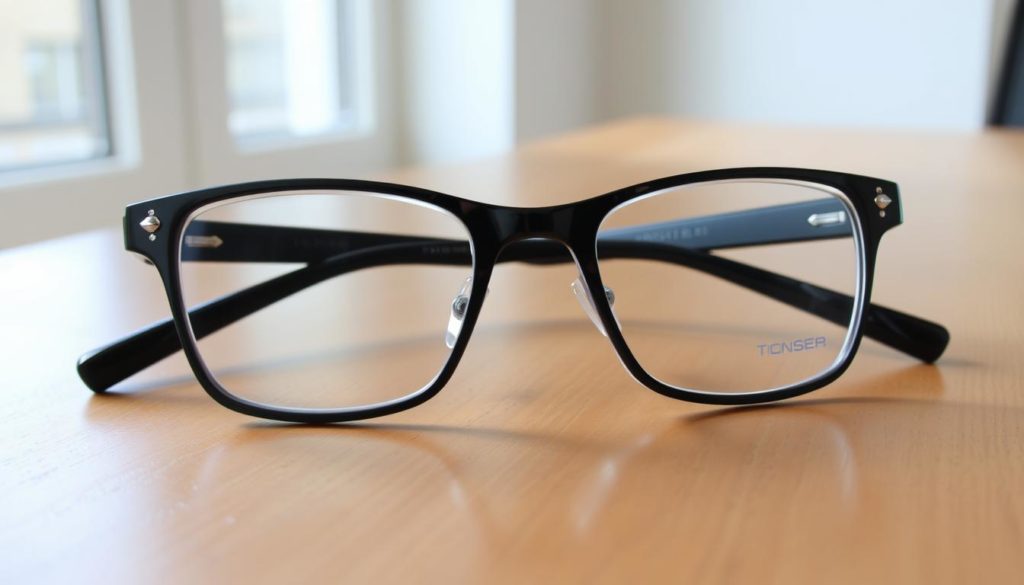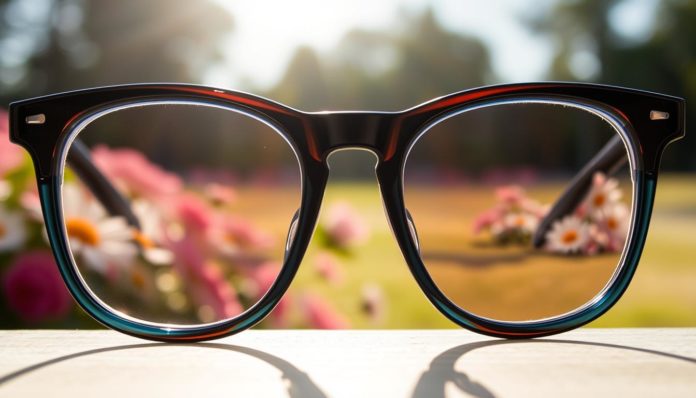Did you know over 50% of Americans over 45 face presbyopia? This is the age-related problem of seeing things up close. It shows the need for better vision solutions. Progressive lenses are a game-changer, offering advanced technology for different vision needs.
Progressive lenses make life easier by smoothly switching between vision zones. This means no more switching between glasses. They’re perfect for today’s fast-paced world where convenience matters. Plus, they look sleek and stylish, combining function and fashion.
Want to know more? Explore our detailed guide to see if progressive lenses are for you. Discover the many benefits they bring.
What Are Progressive Lenses?
Progressive lenses are a new way to correct vision for different distances. They blend different vision powers smoothly. This makes it easy to see near, intermediate, and far distances without trouble.
Definition and Features of Progressive Lenses
Progressive lenses don’t have the lines found in bifocals or trifocals. This makes them look more natural and stylish. They also have a special design that changes power from top to bottom, making vision smooth.
How Progressive Lenses Differ from Other Lenses
Progressive lenses offer a continuous view without the sudden changes of bifocals or trifocals. This makes seeing easier and reduces eye strain. They are loved for their mix of function and fashion.

Are Progressive Lenses Right for You?
Figuring out if progressive lenses are right for you means doing a detailed vision needs assessment. These lenses are great for people with presbyopia. They help with different vision needs.

Presbyopia starts when people are in their 40s or 50s. It happens because the lens in the eye gets harder. Progressive lenses are perfect for correcting this, making it easy to see at different distances.
They’re great for people who need to see clearly at many distances. This means you don’t need to carry around multiple pairs of glasses. You also won’t see the lines that bifocals and trifocals have.
People who are always on the move also like progressive lenses. They’re good for reading, driving, or working on a computer. An eye doctor can help figure out if these lenses are right for you based on your vision needs assessment.
Benefits of Progressive Lenses
Progressive lenses offer many advantages for today’s eyewear needs. They are practical, stylish, and versatile. Let’s explore three main benefits of these lenses.
Seamless Vision Correction
Progressive lenses are known for their seamless vision correction. They help you see clearly at all distances without the jarring changes found in traditional bifocals or trifocals. This makes them perfect for everyday use.
Eliminates the Need for Multiple Pairs of Glasses
No more switching between different glasses for different tasks. With progressive lenses, you only need one pair for everything. This saves time and hassle, making them ideal for those with active lifestyles.
Modern Aesthetic Appeal
Progressive lenses are not just useful; they also look great. Their design is sleek and modern, helping you look younger. Unlike bifocals, they don’t have a visible line, fitting perfectly with today’s fashion trends.
How to Choose the Right Progressive Lenses
Choosing the right progressive lenses can be tough. But knowing your vision needs and lifestyle is key. It’s important to find lenses that are both comfortable and functional. Here’s a quick guide to help you choose wisely.
Understanding Your Vision Needs
Start by figuring out your vision challenges. Do you need help with reading, distance, or in-between? Finding lenses that meet these needs is crucial.
Consulting with an Eye Care Professional
Getting advice from experts can really help. Eyecare specialists can tailor lenses just for you. A full eye exam will give them the info they need to find the perfect fit.
Considering Your Lifestyle
Think about your daily life too. Do you spend a lot of time on screens, enjoy the outdoors, or have specific work needs? Analyzing your lifestyle helps find lenses that are comfortable and work well. This ensures you get the best vision and satisfaction.
Progressive Lenses vs Bifocals
Choosing between progressive lenses and bifocals can greatly affect your daily vision. Knowing their differences, benefits, and drawbacks is key to making a good choice.
Key Differences Explained
Progressive lenses offer a seamless visual transition. They don’t have the clear line found in bifocals. This makes them a popular choice for those who want a smooth change in vision.
Bifocals, on the other hand, have a clear line between near and far vision areas. This can cause eye strain and requires more head movement. But, bifocals are easier to get used to.
Pros and Cons of Each Type
| Feature | Progressive Lenses | Bifocals |
|---|---|---|
| Seamless Vision Transition | Yes | No |
| Adjustment Period | Longer | Shorter |
| Aesthetic Appeal | High | Low |
| Visual Comfort | High | Moderate |
| Cost | Higher | Lower |
Doing a detailed vision solutions evaluation can help pick the best option for you. The choice between progressive vs bifocal depends on your specific needs and preferences. It’s important to consider the lens type advantages and their downsides to find the best fit for your vision.
Pros and Cons of Progressive Lenses
Looking into multifocal eyewear means weighing the good and bad of progressive lenses. They have many benefits but also some downsides.
Advantages
Progressive lenses give you visual freedom at all distances. They smoothly switch between near, intermediate, and far vision. Unlike bifocals, they don’t have visible lines.
- Seamless Vision: No lines divide the lenses, creating a smoother visual experience.
- Enhanced Aesthetics: Modern design without lines enhances the overall look of the glasses.
- Versatility: Suitable for various activities, from reading to driving, offering true visual freedom.
Potential Drawbacks
When looking at multifocal eyewear, it’s key to know the limits of progressive lenses. Some people might find it hard to get used to these lenses at first.
- Initial Adaptation: It may take time to adjust to new lenses.
- Cost: More expensive compared to standard bifocal or monofocal options.
- Peripheral Distortion: Some users may experience minor distortions at the edges of the lenses.
| Aspect | Pros | Cons |
|---|---|---|
| Visual Quality | Seamless transitions | Possible initial distortions |
| Aesthetics | No visible lines | Higher cost |
| Adaptation | One pair for all distances | Adjustment period needed |
Fitting Progressive Lenses
Getting the right fit for progressive lenses is key. An eye care expert takes detailed eye measurements. This ensures the lenses fit perfectly for each person’s needs.
When fitting, the expert looks at your face and how you hold your head. This careful process makes sure the lenses work best for you.
An accurate fitting of progressive lenses means enhanced comfort and functionality, thanks to personalized eye measurements.
The aim is to give you a tailored progressive lenses experience. This means clear vision and happiness with your new lenses.
| Fitting Element | Importance |
|---|---|
| Precision Fitting Process | Avoids discomfort and ensures clear vision |
| Eye Measurements | Aligns lens zones precisely to the eyes |
| Tailored Progressive Lenses Experience | Enhances personalized visual performance |
Getting the fit right is crucial for those trying progressive lenses. It makes the upgrade a big improvement, tailored just for you.
Adjusting to Progressive Lenses
Starting with progressive lenses is an exciting but sometimes tricky journey. Many people need a few days to a couple of weeks to get used to them. This time is normal as your eyes learn to see in a new way.
Initial Adjustment Period
It’s important to know about the first few days. You might see some blurry spots or feel a bit off balance. This is because your eyes are adjusting to the different parts of the lenses.
Tips for a Smooth Transition
Here are some comfort tips to make the switch easier:
- Wear your new glasses every day to get used to them faster.
- Try looking through different parts of the lens to see how they work for different distances.
- Slowly increase how long you wear them each day to get more comfortable.
Following these comfort tips can make the transition smoother. Remember, being patient and persistent is key during this time.
Choosing the Best Progressive Lenses Brands
Many top brands offer the best progressive lenses. They are known for quality and new technology. It’s important to know what each brand offers to choose the right one for you.
Top Brands to Consider
Brands like Essilor, Hoya, and Zeiss are leaders in progressive lenses. Essilor’s Varilux lenses are known for their comfort and technology. Hoya’s lenses are durable and clear. Zeiss is famous for its precise optics and design.
Each brand has its own strengths. So, they are all good choices, depending on what you need.
Factors to Consider When Choosing a Brand
When picking a brand, consider a few things. Look at how each brand compares in technology and features. Check their reputation for being reliable and making customers happy.
Think about your lifestyle too. Do you need lenses for specific activities or lots of screen time? The right brand can make a big difference in your vision and satisfaction.
FAQ
What are the advantages of progressive lenses?
Progressive lenses offer many benefits. They correct vision for different distances without needing to switch glasses. They also look modern and sleek, without visible lines.
How do progressive lenses provide personalized vision solutions?
Progressive lenses are made to fit your specific vision needs. They smoothly change power from top to bottom. This helps you see clearly at all distances.
How does the technology of multifocal lenses work in progressive lenses?
Multifocal technology in progressive lenses changes power gradually from top to bottom. This ensures clear vision at all distances, without the sudden changes of bifocals or trifocals.
What are the main features of progressive lenses?
Progressive lenses have a smooth change in power from top to bottom. They offer clear vision at all distances, without visible lines. This makes them similar to natural vision.
How do progressive lenses differ from no-line multifocal glasses?
Progressive lenses are the same as no-line multifocal glasses. They both have a seamless look and vision, without the lines of traditional bifocals or trifocals.
What does vision zones gradation mean in progressive lenses?
Vision zones gradation means the gradual change in power within progressive lenses. It allows for smooth vision transitions across different distances, without distinct lines.
How do I decide if progressive lenses are right for me?
To decide if progressive lenses are right for you, think about your vision needs. Check if you have presbyopia. Then, talk to an eye care professional to see if these lenses fit your lifestyle.
What vision needs assessment is necessary for progressive lenses?
For progressive lenses, you need a comprehensive eye exam. This exam checks the extent of presbyopia and other refractive errors. It ensures the lenses provide the right visual correction.
Who is the ideal candidate for progressive lenses?
The ideal candidate for progressive lenses has presbyopia and needs clear vision at multiple distances. They prefer a line-free lens and are willing to adjust to the lenses for optimal vision.
How do progressive lenses help with presbyopia correction?
Progressive lenses correct presbyopia by changing power gradually from top to bottom. This allows for seamless focus adjustments and clear vision at all ranges, without separate lens segments.
What are the top benefits of seamless vision correction with progressive lenses?
Seamless vision correction with progressive lenses offers a natural visual experience. It eliminates abrupt changes in lens power. This enhances overall visual comfort and efficiency in everyday activities.
How do progressive lenses eliminate the need for multiple pairs of glasses?
Progressive lenses combine the functions of several glasses into one. They offer clear vision for distance, intermediate, and near tasks. This means you don’t need to switch between different glasses for various activities.
How do progressive lenses provide a modern aesthetic appeal?
Progressive lenses have a smooth, line-free design. They look like single-vision lenses, giving them a modern and youthful appearance. This aligns with contemporary fashion trends in eyewear.
What should I understand about my vision needs before choosing progressive lenses?
Understanding your vision needs involves recognizing specific visual challenges, like presbyopia. It’s important to determine how progressive lenses can address these needs by providing clear vision at varying distances.
Why is consulting with an eye care professional important when choosing progressive lenses?
Consulting with an eye care professional ensures your progressive lenses are tailored to your unique vision requirements. They help with accurate lens prescription, precise fitting, and optimal visual comfort and function.
How does considering your lifestyle help in choosing progressive lenses?
Considering your lifestyle activities helps ensure the progressive lenses you choose will accommodate all aspects of your daily life. This provides maximum convenience and comfort.
What are the key differences between progressive lenses and bifocals?
Progressive lenses offer a seamless vision transition without visible lines. Bifocals have distinct zones for different distances, separated by visible lines, leading to abrupt vision changes.
What are the pros and cons of progressive lenses vs bifocals?
Progressive lenses offer a modern, seamless appearance and gradual vision transitions. However, they can be costlier and have an adjustment period. Bifocals are less expensive and have a shorter adjustment period. But, their visible lines can be seen as less aesthetically pleasing and may cause visual discomfort due to abrupt changes.
What are the main advantages of progressive lenses?
The main advantages include continuous and smooth vision correction at all distances. They have a modern and aesthetically pleasing line-free design. Plus, you only need one pair of glasses for various tasks.
What potential drawbacks should I consider with progressive lenses?
Potential drawbacks include a higher cost compared to bifocals or monofocals. There’s also an initial adjustment period where some users may experience visual distortion or discomfort while adapting to the new lenses.
How important is the precision fitting process for progressive lenses?
Precision fitting is crucial for progressive lenses. It ensures the alignment of the different vision zones with your eyes. This is important for comfortable and effective vision correction tailored to your unique facial features and habitual head posture.
What does a tailored progressive lenses experience involve?
A tailored progressive lenses experience involves customized lens design and precision fitting based on comprehensive eye measurements. This ensures the progressive lenses provide optimal performance, comfort, and visual clarity.
How long is the initial adjustment period for progressive lenses?
The initial adjustment period for progressive lenses can last from a few days to a couple of weeks. It depends on the individual’s adaptability and consistent use of the new lenses.
What tips can help ensure a smooth transition to progressive lenses?
Tips for a smooth transition include wearing the new lenses consistently. Practice looking through different parts of the lens to get accustomed to the vision zones. Gradually increase usage duration to help your eyes and brain adapt to the new visual experience.
What are some top brands to consider for progressive lenses?
Some top brands for progressive lenses include Essilor, Hoya, Zeiss, and Varilux. These brands are known for their quality, innovative technologies, and reputation in the optical industry.
What factors should I consider when choosing a progressive lenses brand?
When choosing a progressive lenses brand, consider lens quality, the brand’s reputation, technological innovations, and whether the lenses meet your specific vision needs and preferences for comfort, performance, and style.


